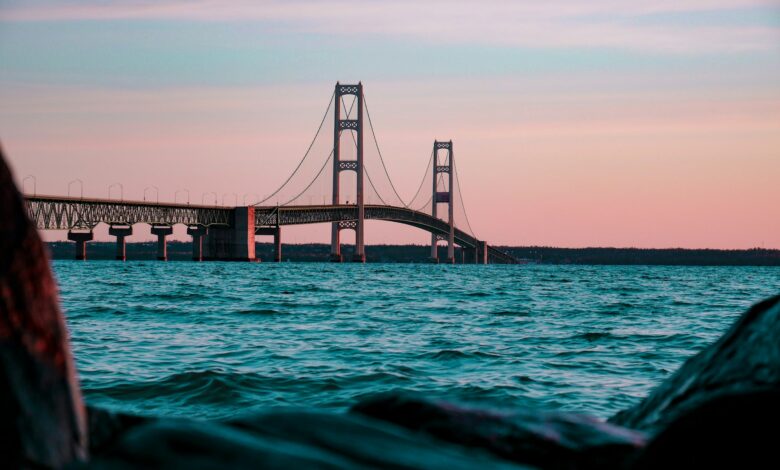
[ad_1]
Let’s dive deep into the wonders of Michigan, a state that captivates the imagination with its stunning natural landscapes, rich industrial history, and charming small towns. From the majestic Great Lakes to its vibrant art and music scenes, Michigan has something to offer every traveler, nature lover, and history buff alike. Join us as we explore the diverse and fascinating aspects of the Great Lakes State – you’ll soon discover that there’s more to Michigan than meets the eye!
What Food is Michigan Known For?
Pasties
A savory staple in Michigan, especially in the Upper Peninsula, is the pasty (pronounced ‘pass-tee’). This hearty, handheld pie has roots in the Cornish tradition, brought over by immigrant miners. Encased in a flaky crust, the classic pasty is brimming with tender meat, rutabagas, potatoes, and onions. It’s a comfort food emblematic of Michigan’s mining heritage, symbolizing the melding of cultures and the sustenance needed to fuel hard-working communities. Today, these delicious parcels are enjoyed statewide, cherished for their history as much as their taste.
Coney Dogs
Coney dogs are a iconic part of Michigan’s culinary landscape, particularly in Detroit. This local delicacy is defined by its composition: a plump hot dog, a generous spoonful of hearty beef chili, finely chopped onions, and a swirl of yellow mustard, all nestled into a soft, warm bun. This meld of flavors creates a comfort food experience that’s synonymous with Michigan’s gastronomic culture. Coney dogs have become pillars in neighborhood diners and statewide food festivals alike, standing testament to Michigan’s love for soulful, communal eats.
Traverse City Cherries
Traverse City, fondly dubbed as the “Cherry Capital of the World”, celebrates Michigan’s esteemed cherry heritage. Nurtured by the area’s unique climate, Traverse City produces a third of America’s tart cherry crop. Every July, the city hosts the National Cherry Festival, showcasing cherry-infused foods and cherry-inspired events. Beyond this, local shops carry a myriad of cherry products all year round: from jams and pies to wines and candies. A visit to Traverse City isn’t complete without sampling these ruby-red delights—a testament to Michigan’s abundant and flavorful bounty.
Mackinac Island Fudge
Mackinac Island Fudge is a sweet indulgence synonymous with the charm and tradition of Michigan’s Mackinac Island. Produced locally since the late 19th century, this decadent treat is made with rich cream, sugary syrup and premium chocolate, expertly crafted on marble slabs. The ‘fudgies,’ as visitors are often playfully called, are drawn to the island by the scent and sight of this fudge-making spectacle—one that echoes with tradition. Available in an array of flavors, from classic chocolate to inventive blends, Mackinac Island Fudge is a must-try for anyone with a sweet tooth visiting this enchanting locale.
Detroit Style Pizza
Detroit-style pizza, an icon of Michigan’s largest city, is a thick, square, deliciously cheesy pie. Its soft interior, combined with a crunchy, caramelized cheese crust, sets it apart from other pizza traditions. Originating in 1946 in Detroit’s Buddy’s Rendezvous, this pizza style has become a culinary sensation nationwide. The magic lies in the baking process, utilizing steel pans that were originally used as trays in Detroit’s auto factories. The steel pan results in a pizza that is crispy on the outside, melt-in-your-mouth soft on the inside, and topped generously with rich, zesty tomato sauce—a Michigan treasure.
What is Michigan’s Signature Drink?
Hummer Cocktail
The Hummer cocktail, a creamy blend of ice cream, white rum, and Kahlua, hails from Detroit, Michigan. Invented in the mid-1960s by Jerome Adams, a bartender at the city’s Bayview Yacht Club, this sweet libation has become a local classic. The name allegedly stems from a customer’s reaction, who after tasting it, said the drink “kinda hums along.” Notoriously potent yet deceptively sweet, it presents as a simple dessert cocktail but packs a strong punch. Today, the Hummer remains a beloved Detroit tradition, setting the tone for jovial celebrations and friendly gatherings.
Vernors Soda
Vernors soda, one of America’s oldest soft drinks, was founded in Detroit, Michigan by pharmacist James Vernor in 1866. This golden ginger soda is beloved for its unique, intense flavor, aged in oak barrels for three years. It packs a robust, spicy punch with a hint of vanilla, a flavor profile much stronger than most ginger ales. Locals consume it not just as a beverage but use it as a cure-all for mild ailments, or even as a mixer in cocktails. Vernors soda holds a special place in Michigan’s culture, embodying the state’s legacy of innovation and resilience.
Cities and Places Michigan is Known For
Detroit
Detroit, a phoenix risen from the ashes, thrives as a symbol of revival and resilience. Home to the legendary Motown sound and the hub of the U.S. auto industry, the city pulses with innovation and cultural riches. The Detroit Institute of Arts beckons with world-class exhibits, while the hum of historic Woodward Avenue mirrors America’s love affair with the automobile. Detroit’s rich culinary tapestry, painting flavors from deep dish pizzas to craft cocktails, mirrors its dynamic rebirth. This city doesn’t just tell tales of history—it creates a vibrant narrative for the future.
Traverse City
Traverse City, endearingly known as the “Cherry Capital of the World”, hangs like a charm amid Michigan’s picturesque beauty. Nestled on the shores of Lake Michigan, it’s renowned not just for its bountiful cherry orchards, but also for its vibrant arts scene and outdoor allure. The city proudly showcases its heritage through the National Cherry Festival, an annual celebration of the region’s famed produce. Additionally, Traverse City’s wine trails, eclectic shopping, and myriad of water sports make it a year-round destination. It’s a city where natural beauty entwines with a zest for life and culture.
Tahquamenon Falls State Park
Awash with nature’s beauty, Tahquamenon Falls State Park invites awe-struck wonder. Located in Michigan’s Upper Peninsula, this captivating park is home to the iconic Tahquamenon Falls, consisting of a boundlessly majestic upper falls and a serene, cascading lower falls. Its lush, resplendent foliage and diverse wildlife paint a vibrant scene, making it a haven for outdoor enthusiasts. Hiking, snowshoeing, and canoeing are just a few of the activities the park offers. Tahquamenon Falls State Park transforms every visit into an enchanting embrace of wilderness, beckoning those who seek wonder and solace in nature.
Grand Rapids
Grand Rapids, often dubbed Beer City USA, fuses cosmopolitan flair with Midwestern charm. The city’s craft beer scene is unmatched, with an impressive array of breweries dotting the streets. Grand Rapids also prides itself on a vibrant art community, epitomized by the revolutionary ArtPrize competition that transforms the city into a sprawling canvas for creatives. Further cultural encounters can be found in its museums and theaters. Nestled along the Grand River, with trails and parks surrounding its urban core, Grand Rapids offers both urban excitement and natural retreats, making every visit both refreshing and invigorating.
Mackinac Island
Stepping onto Mackinac Island feels like a journey back in time, where automobiles give way to horse-drawn carriages and historic architecture lines the streets. This quaint island in Lake Huron, Michigan, evokes a sense of enchantment that captivates visitors. With its famous fudge shops, centuries-old Fort Mackinac, and the elegant Grand Hotel, every turn divulges a charming spectacle. Meanwhile, picturesque landscapes inspire exploration, whether by foot, bike, or even kayak. Mackinac Island casts a spell on those fortunate enough to visit, leaving them with unforgettable memories and a longing to return.
Frankenmuth
Frankenmuth, deemed Michigan’s “Little Bavaria,” captivates with its old-world charms and festive atmosphere. Known for hosting the world’s largest Christmas store, Bronner’s CHRISTmas Wonderland, the town is a year-round holiday haven. Authentic German architecture adorns the streets, inviting visitors to stroll and partake in the town’s famous chicken dinners or explore its cheery beer gardens. Each season in Frankenmuth brings new reasons to celebrate, from summer’s polka-fueled Oktoberfest to the twinkling winter snowscapes. A welcome slice of European culture, Frankenmuth enchants with its blend of tradition, community, and unparalleled festive spirit.
Sleeping Bear Dunes National Lakeshore
Nestled along the northeastern shoreline of Lake Michigan, Sleeping Bear Dunes offers an exceptional blend of majestic beauty and outdoor adventure. Its towering sand dunes—among the tallest in the world—provide breathtaking overviews of the sparkling lake and lush surrounding forest. Visitors can marvel at its rugged terrain via a plethora of recreational activities, including hiking, camping, and dune climbing. In addition, it serves as a habitat for a wide variety of wildlife. Sleeping Bear Dunes, a wondrous natural spectacle, presents limitless opportunities for enchanting exploration and relaxation.
Landmarks and Attractions Michigan is Known For
Henry Ford Museum of American Innovation
The Henry Ford Museum of American Innovation in Dearborn, Michigan, stands as a testament to America’s remarkable legacy of ingenuity. Visitors can delve into America’s story of innovation, from industrious feats such as Henry Ford’s own pioneering automobile assembly line to momentous historical events like the courageous bus ride of Rosa Parks. Showcasing artifacts that revolutionized America, like the Ford Model T and the Wright brothers’ bicycle shop, it provides a fascinating lens into our nation’s progress. Inspiring and enlightening, the museum allows visitors to discover the power of ideas that shape our world.
Ford Field
Located in the heart of Detroit, Ford Field stands as a gleaming hub of sports and entertainment, housing the audacious Detroit Lions of the NFL. With vast seating that echoes roars under the lights, this modern arena effortlessly shifts from thrilling gridiron battles to grand concerts and bustling conventions. Notably integrating the city’s industrial heritage, the stadium nestles the historical Hudson’s warehouse facade within its contemporary design. Ford Field does more than host events; it embodies the pulsating rebirth of Detroit, inviting fans and visitors to partake in its unfolding legacy.
Pictured Rocks National Lakeshore
Pictured Rocks National Lakeshore astonishes visitors with its multicolored sandstone cliffs that artfully etch Michigan’s Upper Peninsula shoreline. Nature has meticulously sculpted these towering formations, creating dramatic folds and crevices that plunge into the crystal-clear waters of Lake Superior. The area invites endless outdoor activities, from hiking scenic trails and kayaking alongside the vibrantly hued cliffs to winter ice climbing and serene stargazing. This national treasure encapsulates the raw beauty of wilderness, offering a serene retreat and an array of photographic opportunities to those seeking the pristine spectacle of nature’s handiwork.
Comerica Park
In the bustling heart of Detroit, Comerica Park unfurls as a festive playground for baseball and entertainment. Since 2000, it has resounded with the cheers of Tiger fans, adding a modern chapter to Detroit’s storied baseball history. More than a baseball stadium, Comerica houses a carousel, a Ferris wheel, and a museum honoring Tiger legends, delivering an atmosphere that ignites the joys of summer. Its open-air design invites views of the city skyline, creating a unique backdrop to fiery pitches and heavy-hitting home runs. Comerica Park, filled with nostalgia and anticipation, brings the community together in celebration of America’s pastime.
Frederik Meijer Gardens and Sculpture Park
Frederik Meijer Gardens & Sculpture Park, nestled in Grand Rapids, is a serene fusion of art and nature. This vast oasis showcases an internationally acclaimed sculpture collection amidst an array of diverse gardens, each carefully curated to harmonize with Michigan’s seasons. It’s a place where visitors wander through nature trails, encounter inspiring outdoor art installations, and delight in the butterfly and tropical conservatories. With educational programs and rotating exhibitions, Meijer Gardens is a dynamic cultural destination that nurtures discovery, offering a tranquil yet engaging escape for all ages.
Motown Museum
Immersed in the melodic legacy of Detroit, the Motown Museum sings the narrative of a groundbreaking music phenomenon. Stepping into its hallowed space, visitors travel back to a time when Smokey Robinson, Stevie Wonder, the Supremes, and other legendary artists honed their harmonies. The modest house on West Grand Boulevard, once headquarters of Motown Records, preserves Studio A and other historic locales, undisturbed since the 1960s. This shrine of rhythm and blues, soul, and the unique “Motown Sound,” resonates with music history, preserving the legacy of influential musicians and the genius of founder Berry Gordy.
Soo Locks
The Soo Locks, an engineering marvel in Michigan’s Upper Peninsula, serve as the bustling water highway between Lake Superior and the lower Great Lakes. Opened in 1855, this system of parallel locks allows safe passage for vessels, circumventing the challenging rapids of the St. Marys River. Visitors marvel at the colossal freighters gliding smoothly up and down through the locks, guided by an intricate choreography of water and gravity. With free public viewing platforms and a visitor center, the Soo Locks remain a fascinating testament to human ingenuity in harnessing the power of nature for commerce and transportation.
The Ford Piquette Avenue Plant
The Ford Piquette Avenue Plant stands in Detroit as the birthplace of the Model T, the automobile that put the world on wheels. This humble brick building reverberates with the innovation of the early 20th century, where Henry Ford and his team reimagined transportation. Restored to its original condition, the plant now opens its doors to history enthusiasts, showcasing pristine vintage cars and telling riveting stories of the automotive industry’s infancy. A visit to Piquette is a step back in time, illuminating the relentless spirit of invention that drove society onto the fast lane of progress.
Unique Capitol Building
An ardent example of Victorian-style grandeur, Michigan’s Capitol Building illuminates downtown Lansing with its striking architecture and lavish interior. What distinguishes this National Historic Landmark is its collection of nine extraordinary Tiffany chandeliers. Adorning the Senate and House chambers and the old Supreme Court, these intricate masterpieces cast a warm glow over the mahogany and walnut interiors, effortlessly merging artistry with function.
World’s Largest Weathervane
In Montague, Michigan, the world’s largest weathervane stands tall, casting its mesmerizing presence over the White River. Completed in 1984, the remarkable steel structure, created by local artist Whitey (William H.) Horton, is an astonishing 48 feet tall, with an arrow measuring 26 feet long. The massive sculpture depicts the Ella Ellenwood, a historic lumbering schooner that once sailed Lake Michigan. As it gracefully pivots with the changing winds, this awe-inspiring landmark beckons visitors to the waterfront, kindling a connection with the area’s maritime roots while showcasing the captivating fusion of art and science.
History, Culture and Other Things Michigan is Famous For
Great Lakes State
Michigan, endearingly known as the Great Lakes State, is uniquely defined by its deep connection with the surrounding freshwater giants. Encircled by four of the five Great Lakes – Huron, Erie, Michigan, and Superior – Michigan boasts the longest fresh water coastline in the United States. The lakes serve as a splendid backdrop for the state’s bountiful outdoor activities, from sailing and fishing to beachcombing and lighthouse tourism. More than just an idyllic playground, these vast water bodies reflect Michigan’s economic, cultural, and environmental identity, reinforcing why it proudly carries the moniker of the Great Lakes State.
Mitten State
Michigan is prevalently referred to as “The Mitten State” due to the uncanny resemblances its lower peninsula bears to a mitten. This peninsular shape, with its distinctive protruding thumb and rounded base, is instantly recognizable, accurately outlining a mitten on geographical maps. It’s a nickname embraced by Michiganders as a term of endearment and identity, often used to demonstrate their location by pointing to a part of their own hand. Beyond its geographical resemblance, this moniker warmly alludes to Michigan’s welcoming spirit, just as a mitten warmly embraces a hand in the frigid Midwestern winters.
Auto Industry
Michigan’s fame as the crucible of the auto industry dates back to the early 20th century, with Detroit earning the moniker “Motor City.” Home to the “Big Three” – Ford, General Motors, and Chrysler – it’s the heartbeat of America’s car manufacturing and innovation. Henry Ford’s introduction of the assembly line in the Ford Motor Company revolutionized production, significantly reducing costs and making cars accessible to the masses. The state’s profound ties to the industry are not just historical but ongoing, as Michigan continues to drive advancements in automotive technology and shapes the future of transportation worldwide.
Lighthouses and Coastline
Michigan’s extensive shoreline is a beacon for lighthouse aficionados, boasting the most lighthouses in the country, with over 120 dotting its Great Lakes coasts. These historical sentinels have guided sailors through treacherous waters for centuries and now stand as picturesque monuments to maritime heritage. Their diverse designs and stories enchant thousands, offering a glimpse into a bygone era of seafaring adventure. Whether they’re seeking the romance of a coastal sunset or the thrill of a historical journey, visitors are lured to explore these towering beacons and the rugged beauty they illuminate.
Wine
Michigan’s unique climate and rich, glacial soil create an ideal terroir for a flourishing wine industry. With over 140 commercial wineries spreading across five recognized American Viticultural Areas, Michigan produces a diverse range of wines. Its cool climate particularly favors aromatic white varieties like Riesling and Pinot Blanc, as well as reds like Cabernet Franc. Michigan is also nationally recognized for its fruit wines and ice wines, offering distinct flavors that capture the state’s natural bounty. Wine tourism is ever-growing, inviting connoisseurs to explore picturesque vineyards, taste award-winning wines, and immerse themselves in the state’s agricultural charm.
First State to Abolish the Death Penalty
In 1846, Michigan became the first state to officially abolish the death penalty, setting a pioneering precedent for human rights and criminal justice reform in the United States. Motivated by a transformative public sentiment and the persistent advocacy of progressive lawmakers, such as Governor William L. Greenly, Michigan ended the use of capital punishment for all crimes except treason. This historic milestone not only reflected the state’s commitment to value life, even of those convicted of heinous crimes, but also ignited an ongoing national debate, inspiring other states to reevaluate their stances on the death penalty.
First Tunnel Connecting Two Countries
The St. Clair River Tunnel, inaugurated in 1891, is the first tunnel ever built to connect two countries – the United States and Canada. An engineering marvel of its time, it provided a significant boost to railway transportation, seamlessly linking Port Huron, Michigan with Sarnia, Ontario. The tunnel stands as a testament to the close intercontinental relations, promoting cross-border trade and human exchange. While a new, larger tunnel replaced it in 1995 to accommodate larger freight trains, the original tunnel remains an impressive symbol of thriving international cooperation and technological progress.
Floating Post Office
The J.W. Westcott II, based in Detroit, Michigan, holds the unique distinction of being the world’s only floating post office. Founded in 1874, the Westcott company’s maritime mail delivery service has been officially recognized by the USPS since 1948. The boat not only delivers mail and packages to ships while they’re underway through its “mail-in-the-pail” system, but it also provides other marine services, such as towing and emergency responses. As a floating post office, the J.W. Westcott II upholds an enduring tradition, serving the Great Lakes shipping industry in a distinctive, resourceful manner.
Beer
Michigan’s beer scene is a burgeoning force in the American craft beer landscape. With over 300 breweries, it ranks fifth in the nation for its number of craft breweries, and the quality matches the quantity. Internationally recognized craft beer powerhouses, like Founders and Bell’s, call Michigan home, while an array of smaller breweries enrich the diversity of flavors. From rich stouts to balanced IPAs, Michigan’s beer stands apart for its innovative spirit and commitment to local ingredients, particularly cherries and, increasingly, hops. Beer enthusiasts flock to Michigan’s brewpubs, beer festivals, and craft beer trails, confirming its status as a beer-lover’s destination.
First Regularly Scheduled Air Service
In 1926, Stout Air Services initiated Michigan’s first regularly scheduled air service. As a division of the Ford Motor Company, Stout paved the way for commercial aviation in the region, connecting Detroit and Grand Rapids. This pioneering service was operated with forward-thinking, all-metal Ford aircraft conducive to the evolving demands of air travel. This maiden voyage within Michigan’s boundaries represented a progressive step forward, not only showcasing the state’s industrial adaptability beyond the automotive sector but also underscoring its commitment to embrace and foster innovative transportation solutions that would eventually shape the future of domestic air travel in the United States.
Famous People From or Connected With Michigan
Stevie Wonder
Stevie Wonder, born Stevland Hardaway Judkins in 1950, is one of Michigan’s most renowned cultural icons. Hailing from Saginaw, his groundbreaking music career began when he signed with Detroit’s Motown Records at just 11 years old. Known for his extraordinary talent as a singer, songwriter, and multi-instrumentalist, Wonder rose to fame in the 1960s and 70s, popularizing the soul and R&B genres. His Michigan roots significantly influenced his musical styling and activism, and despite his international fame, Wonder’s love for his hometown remains evident. He continues to be a global ambassador for Michigan’s vibrant musical heritage.
Taylor Lautner
Taylor Lautner, an American actor and model, was born on February 11, 1992, in Grand Rapids, Michigan. Best known for his role as Jacob Black in the “Twilight” saga, Lautner was ushered into the Hollywood limelight at a young age. Despite his international fame, he maintains strong ties with his home state. Lautner’s karate lessons, taken from a young age in Michigan, helped shape his later roles, including his breakout performance in “Twilight.” His early life in Michigan laid the foundation for his successful career, demonstrating that the state is a fertile ground for nurturing world-class talent.
Eminem
Eminem, born Marshall Mathers III, is a significant figure from Michigan’s vibrant music scene. Raised in Detroit, Eminem tapped into the city’s gritty atmosphere, channeling his struggles into rap. His groundbreaking work in hip-hop pushed boundaries, and his ties to Michigan significantly influenced his music. With Detroit playing an essential backdrop to his life and message, Eminem’s songs often highlight his experiences growing up in the economically challenged city, offering an unvarnished perspective of life in urban America. His success story illustrates the transformative power of music and positions him as a proud representation of Michigan’s unique cultural mix.
Kid Rock
Kid Rock, born Robert James Ritchie in Romeo, Michigan, is a musician who embodies the spirit of his home state with a blend of rock, hip-hop, and country music. Infusing his work with Michigan’s blue-collar ethos, Kid Rock’s career soared in the late 1990s with hits like “Bawitdaba” and “Cowboy.” Known for celebrating and supporting his Michigan roots, his music often reflects the state’s diverse cultural landscape and its influence on his artistry. Kid Rock’s bond with Michigan is palpable in his philanthropy and public support for the community, solidifying his status as a Michigan icon.
What is Michigan Known For Producing?
Beans
Michigan’s fertile soil conditions and favorable climate position it as a leading producer of a diverse range of beans in the United States. Beans have been grown in Michigan for over a century, featuring prominently in the state’s agricultural economy. Providing a rich variety, including black, navy, cranberry, small red, and great northern beans, Michigan leads in the production of black beans and cranberry beans nationwide.
Tart Cherries
Michigan is the leading producer of tart cherries in the United States, often referred to as the “Cherry Capital.” Its unique climate provides optimal conditions for cherry trees to thrive. Primarily grown in Northwest Lower Michigan, the annual yield of tart cherries can reach up to 200 million pounds, used in pies, jams, and dried snacks across the country and globally. This dominance in tart cherry production isn’t just an agricultural triumph but also a significant cultural emblem for the state, celebrated through annual traditions like the National Cherry Festival in Traverse City.
Asparagus
Michigan ranks among the leading states in asparagus cultivation, benefiting from its temperate climate and muck soil fields. The state’s Oceana County, known as the “Asparagus Capital of the Nation,” spearheads production. The green, tender shoots harvest kicks off the state’s vegetable growing season, signifying a fresh, bountiful start. With approximately 20 million pounds harvested annually, Michigan’s asparagus is prized for its freshness and nutritional value. The vibrant local industry not only supports the economy through agriculture and processing jobs but also through community events celebrating the vegetable’s seasonal arrival.
Cement
Michigan has a rich history of cement production, notable since the development of “Portland” cement in the 19th century. The state’s abundant limestone and shale – essential ingredients for cement – are mined from large quarries, particularly in the Alpena and Bay City areas. Michigan’s cement plants contribute significantly to the construction industry by supplying high-quality, durable cement for various development projects both locally and nationwide. The cement industry not only bolsters Michigan’s economy through direct and indirect employment but also supports vital infrastructure development, playing an integral role in building and maintaining the state and the nation.
More Reading:
[ad_2]
Source link






